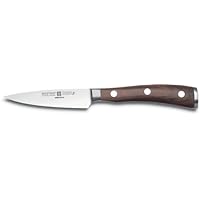 As Wusthof official statements put it, the Ikon Blackwood is the jewel of Wusthof. It is the most expensive line of all Wusthof cutlery lines.
As Wusthof official statements put it, the Ikon Blackwood is the jewel of Wusthof. It is the most expensive line of all Wusthof cutlery lines.In short summary,
Pros: Decent stainless steel grade, excellent reduced bolster design, excellent ergonomic handle, good weight, beautiful wood handle, an overall attractive knife
Cons: High cost (when not on sale), the knife balance may shift too much to the handle for a paring knife.
The Classic Ikon series and the Ikon Blackwood series are essentially the same, except for the handle, where the Classic Ikon handles are made with hard plastic and Ikon Blackwood handles are made from African Blackwood (Grenadill wood). Currently, the Ikon Blackwood paring knife is being sold at $80 and the Classic paring knife is $60. Both are forged knives made with a good quality steel blade, an ergonomic handle, a full tang, a reduced (heel-less) front bolster and an additional bolster at the end of the handle butt. Despite the marketing statements claiming it is a high carbon stainless steel knife, it isn't. X50CrMoV15 is the stainless steel grade here, so it has 0.5% carbon and that is not considered high by today standard. In contrast, VG-10 (used in Shun Classic knives and Tojiro knives) has 0.95%-1.0% carbon and SG-2 (used in Shun Elite) has 1.25-1.45% carbon. Nevertheless, X50CrMoV15 makes a tough knife with good corrosion resistant. In other words, the edge rolls easily compared to most Japanese knives, but this steel has good resistance against chipping and rusting.
What I really appreciate about the Ikon line is its reduced bolster. The traditional full bolster which extends the entire knife heel makes sharpening difficult. Ikon solves this problem nicely by reducing the bolster. The knife edge is fairly sharp out-of-the-box compared to other knives, but it could have taken a much better edge. I sharpened it on diamond stone and then on Japanese water stones. I can vouch from my experience that the reduced bolster has made the knife much easier to sharpen. The ergonomic handle is truly ergonomic as it claims. It fits my hand nicely. The second bolster on the back of the handle shifts the center of gravity significantly toward the handle. It probably works better for larger knives, like a Chef's knife, but for a small blade paring knife, I feel it may have shifted the weight slightly much toward the handle. Still, it is not too bad and I can certainly adapt to. The African blackwood is indeed as nice Wusthof claims. It is very beautiful, smooth to touch and best of all: it really does not absorb much water. I bought this knife at $50 and am quiet happy with it. At $80-$125, which is the usual price range for this knife, I think it is high.The only problem with this knife is that it makes the rest of your knives seem almost unusable due to their cheap quality and crude design. Sure, I'm trying to be funny, but it's also quite true, and it is a little bit of a problem because a full set is expensive!
On to a descriptive review. The blade is sharp. Full tang. All the metal you see except the rivets appears to be made of one piece, which, yes, means the tang flairs nicely out where the handle meets the blade. (Most other knives to create this look have a separate piece attached, often a chrome-plated collar that always looks wrong aesthetically to me because the metal is right next to the blade and is similar but not the same colour or sheen and is generally made of a cheap metal.)
The shape is strong and elegant. Feels wonderful in the hand. Smooth but secure.
This is somewhere between a woodsman's trusty boot knife and a surgeon's scalpel, turning out to be perfect as one of the commonly most-used "core" cooking knives in the kitchen. I don't know if it's worth the price to get a whole set or even all of your top most-used 3 or 4 knives, but at less than $90, the paring knife is within easier reach.
The blackwood (grenadill) wood is hard and attractive, perhaps slightly darker than the photo, or that may be after some use. Many kinds of wood get better with natural polishing simply from being used.
I prefer wood to plastic handles. Be careful when comparing prices if you do too -Wusthof has somewhat less costly knives which look just like these but with plastic handles. The plastic ones are paradoxically called "Classic Ikon" whereas this wood-handled version is simply "Ikon". (Keep in mind people may forget to mention the word "Classic" in the description.) With how much I use this knife, it has a fair chance of eventually resting along side a stove-top's burner touching or almost touching the heating element. If or when that happens I'd rather have it singed than melted.
Balance point is far back, just beyond the middle rivet. For a throwing knife, I like the balance point near the choil, but for a kitchen knife, this balance feels nice.
Enjoy!
Buy Wusthof Ikon 3-1/2-Inch Paring Knife with Blackwood Handle Now
The blackwood series knives are really nice looking and function great; they are hard to beat. You will not be disappointed with the overall looks of any of them. The classic are attractive and great functioning knives. I have both because there are some knives that I wanted that don't come in blackwood. Anyway, for the price, they are really good knives.Read Best Reviews of Wusthof Ikon 3-1/2-Inch Paring Knife with Blackwood Handle Here
It's a superior knife. Beautiful handle, superb ergonomics, keen edge, full warranty. It's a Wusthof, what more can be said.Want Wusthof Ikon 3-1/2-Inch Paring Knife with Blackwood Handle Discount?

0 comments:
Post a Comment